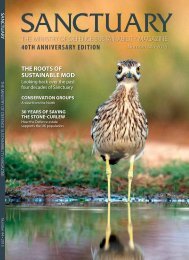SUSTAINABILITY
UBUt5
UBUt5
Create successful ePaper yourself
Turn your PDF publications into a flip-book with our unique Google optimized e-Paper software.
AROUND THE REGIONS<br />
9<br />
Hampshire<br />
DIO SD Training Home Counties<br />
Fairy shrimps are sexually dimorphic © Iain Perkins<br />
Aldershot Training Area in Hampshire<br />
contains a mosaic of open heathland<br />
and rough grassland, woodland (both<br />
conifer and broadleaved), and an<br />
extensive rough track network. The<br />
majority of the areas are designated as a<br />
Site of Special Scientific Interest and form<br />
part of the European designated Thames<br />
Basin Heaths Special Protection Area.<br />
In 2014, the DIO Conser vation Team<br />
followed up on a repor t from<br />
conser vation group member John<br />
Eyre that fair y shrimp Chiro ce phalus<br />
dia phanus had been found on the<br />
training area in 2013. Two sur veys<br />
were then carried out within the<br />
B 4D area to see if the species was<br />
still present.<br />
ponds by laying eggs that lay dormant<br />
in the substrate of temporary ponds.<br />
During dry periods the eggs are<br />
dispersed on the wind, on the hooves<br />
of livestock and by vehicle movements<br />
until they are wetted again through<br />
rain, when they hatch, quickly<br />
colonising new ponds.<br />
Therefore fair y shrimp favour<br />
temporar y ponds where there is a<br />
seasonal precipitation/evaporation<br />
deficit, which causes the ponds to<br />
periodically dr y out, removing<br />
predators such as fish. The ideal<br />
ponds stay wet for four months of<br />
the year; the temporar y ponds on<br />
the B4D Training Area created by<br />
vehicle ruts and track s fit this<br />
description and have great potential<br />
to supp or t fair y shrimp.<br />
A visual survey was carried out in June<br />
of 62 semi-permanent ponds on the<br />
area but no fairy shrimp were found. At<br />
the same time, a characteristic<br />
assessment of the ponds was carried<br />
out to check habitat suitability. The<br />
team returned to carry out a sweep<br />
net survey (under licence) in<br />
November, and found fairy shrimp<br />
within a cluster of small non-vegetated<br />
ponds, with a sandy soil substrate, that<br />
were previously dry. Approximately ten<br />
adult individuals were observed in<br />
each pond, 50/50 male and female.<br />
It is not clear how the fairy shrimp<br />
arrived on the training area, it could<br />
have been through vehicle and troop<br />
movements from Salisbury Plain or<br />
they may be part of a relic population<br />
which has been there for many years.<br />
Another notable species found during<br />
the survey was the small red damselfly<br />
Ceriagrion tenellum which was seen<br />
hoovering around a temporary pond<br />
in the sun.<br />
Conservation Group Team<br />
Defence Infrastructure Organisation<br />
Previously widely distributed across<br />
England and Wales the species is now<br />
nationally scarce in Britain; the MOD<br />
having the largest metapopulation on<br />
Salisbury Plain.<br />
The fairy shrimp is a translucent<br />
crustacean which is considered to be<br />
quite primitive due to its body<br />
structure. This crustacean is a passive<br />
disperser and is able to colonise new<br />
Even the Training Area Marshall has now become quite the ‘expert’ on fairy shrimps © Crown<br />
82<br />
Sanctuary 44 • 2015



